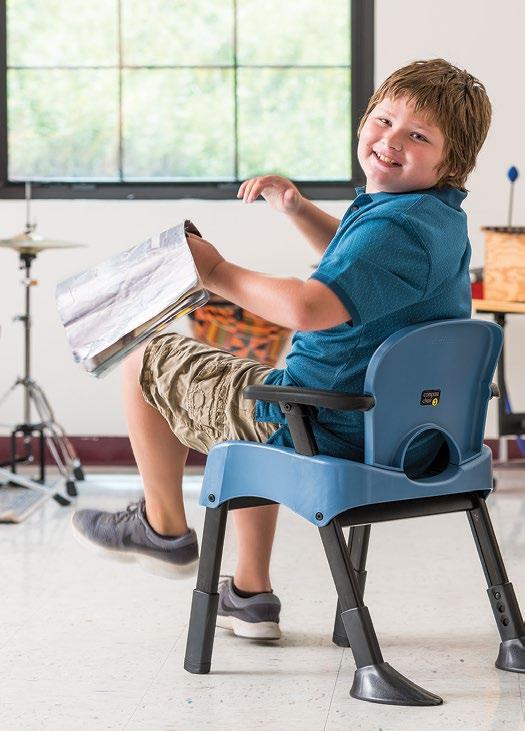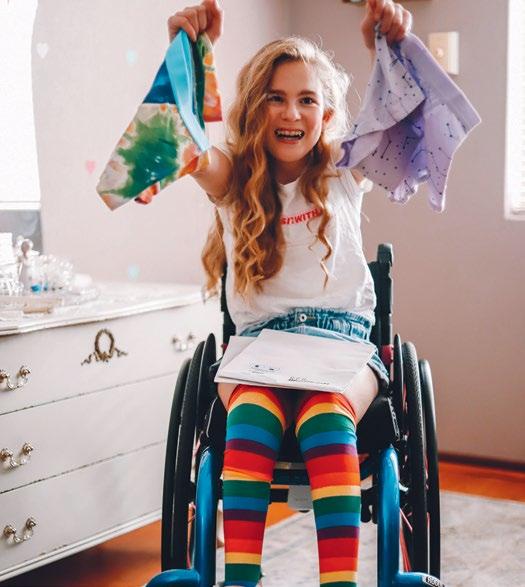
6 minute read
Assisting children with special needs to achieve a level of continence
Tips from an expert on helping your child with toilet training.
Toilet training in children with special needs can be a challenge. Often the child will not display the usual signs of ‘being ready’ to toilet and communication barriers, mobility and cognitive issues all make achieving this goal difficult. Added to this, as parents, we often have other competing goals for our child that take priority, as well as the usual challenges of a busy family life and a lack of time.
So before we know it our child is past the age range for toilet training, they are wearing pull ups and we are not sure when, how or if it is even possible to achieve any level of continence. It becomes a normal routine for us and for them and we struggle to change them in dirty community toilets and get used to going out with an ever growing contents in their ‘change bag’.
So how do we start?? (and is it worth all the effort??) If you would like to try toilet training your child, I would encourage you to start with a goal of teaching your child to do a poo on the toilet. This may be too complicated to teach all at once so you might break this down into smaller more manageable segments. Your first segment might be to encourage your child to sit on the toilet after each meal of the day. The reason for doing this is that the bowel starts to move a stool along its length most strongly about 20 minutes after food has been eaten. This is called the gastric-colic reflex and it is strongest first thing in the morning after breakfast.
But of course getting your child to sit on the toilet for a period of 10 minutes is not necessarily easy. So for segment number 1 you may have to start by building up the length of time they will sit for. Choosing a foot stool is essential to get them sitting in the correct toileting position (see pic 1), and if you purchase something like the Ikea footstool in pic 2 you will have space to sit on the end of it and entertain them!
Pic 1: Knees above the hips straightens the bowel making it easier for the stool to travel to the rectum for evacuation.
Pic 2 www.ikea.com: Choose a stool high enough to raise the knees above the hips to an angle of at least 35 degrees.

It can take anything from 4-6 weeks for the bowel to get into the rhythm of being ready to empty after a meal once your child is sitting for 10 minutes at a time. But as long as 5-15 weeks for the child to ‘perform’ according to research in this area. Relate all bladder and bowel activities back to the toilet Other strategies to This is about making a connection for maximise success your child that what happens in the pull up needs to happen on the toilet. PLAN TO START AT THE RIGHT TIME • Try and change your child in the Trying to fit in an extra 10 minute activibathroom if possible. If not, when you ty during your morning routine may seem have finished the change then encourage like a massive effort so make sure you do them to accompany you to the toilet to as much as possible to achieve success. watch the poo being emptied into the • Consider starting the new routine toilet and flushed away. during the long summer holidays so that • Get them involved by explaining what you have time to get a routine up and is happening (even if you are not sure running. they understand) and encourage them • Consider getting a carer to assist with to flush the toilet, hand over hand if the toileting. necessary. • Make sure you have all the equipment • Tell them when you are going to the you need prior to starting – footstool, toilet. When you have finished tell them books, ipad, pictures on the wall, visual where you have been and what you have aids, toilet seat cover. been doing!


The perfect inclusion chair Rifton Compass Chair offering solid frame, contoured seat and sturdy armrests. Available in 5 sizes, height adjustable legs, lateral thigh supports and optional seat belt and stability feet.

Visit www.medix21.com.au to find your closest distributor.
RE-ENFORCE THE COMMUNICATION
• Use verbal prompts, pictures or hand signs to maximise your child’s understanding. • Make sure that whatever you use, it is not too complicated. So if you are just aiming for a 10 minute sit at first then the strip below may be all you need. • Keep the language the same. If you decide to refer to doing a poo as a ‘number 2’ then make sure that everyone including family, carers, teachers etc. use the same words. The same applies to pictures and hand signs.
BE CONSISTENT
• Keep the routine the same across all environments as much as possible.
PRAISE AND REWARD
• Studies that showed success in the toileting of children and adults with special needs found that the participants were more likely to succeed if they were praised and/or rewarded for their efforts.
toilet iPad finished
G I V E Y O U R C H I L D S O M E L E V E L O F CONTROL
• Let them choose the colour of the sticker if you are using a reward chart. • After you have praised them you might give them the choice between two different snacks or books to read as a reward. Rewards don’t need to be fancy but they do need to happen immediately after the action you are praising.
I hope this article will encourage you to give toilet training a go with your child. Intellectual and physical disability are not necessarily barriers to achieving a level of continence and there are positive gains to be made in ensuring your child’s dignity and encouraging their own self care. Be prepared and plan for a start date so that you can have NDIS funding for a Continence Advisor (which comes from Core funding) to assist you with meeting your child’s goals and prescribe an individual plan for your child that is practical and realistic.
Nicola Mitchell is a Continence Nurse Consultant. For more information on how she can assist you and your child you can contact her atcontinenceadvisor@gmail.com or call 0411 200 783

AurelkaORTO is a leading manufacturer of professional orthopaedic footwear for children. Many models available with fastening options of laces, velcro and BOA. Sizes from first steps to teenagers (EU 15-43).
Prefabricated stock and custom options available
Sold in Australia wellandable.com.au
Wheelchair Raincoat
Shower time can now be fun and safe for everyone!

Nearly 3 children every day are treated in Australian hospitals for burns as a results of scalds, mostly caused by hot water. 80% of those in the bathroom… but the award winning thermostatic shower mixer can help change this.
• Maintain a consistent water temperature • Prevent chance of scalding • Easy child-safe controls • Cool-Touch technology ensures the surface remains cool
www.therm-oz.net.au • Contact Sarah on 0439 992 011










